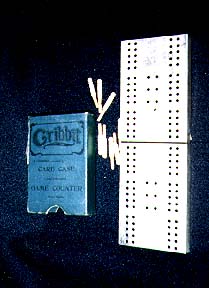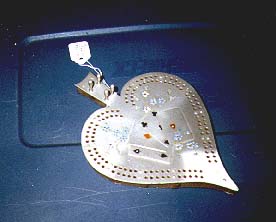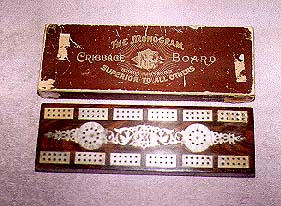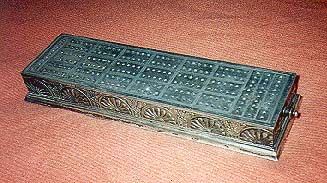♠ Article Library ♦ Board Gallery
Old metal cribbage boards pop up all the time when a collector is searching for something to add to a collection. For the most part, however, their origins are vague or unknown, and it is even difficult sometimes to determine whether they were manufactured in the United States or Great Britain. I am relatively certain however, that the boards featured in this article were manufactured in this country, and the reasons soon become apparent as you read on!

The Gribbit board is of very simple construction, a hollow metal shell which holds a deck of playing cards and pegs when folded. The cards can be removed without unfolding the board, adding to the simplicity of design. Although its origin hasn't yet been determined, at least two of the boards have recently surfaced in upper New York state, leading me to suspect that the manufacturer was located in that area. The case and board appear to be early 20th Century, but could possibly be earlier, as it was called a Game Counter. It was popular for the game boards of the Victorian era to be used for scoring in multiple games such as Gin Rummy, Pinochle, Dominoes, Whist, Bezique, and of course Cribbage. I have discovered that Patents from the 19th Century more commonly refer to cribbage boards as game counters, game boxes, game boards and game tables. The Gribbit is marked "Pat Pend'g", but one hasn't surfaced yet. By the way, this board measures 4" X 2 12" X 5/8" when folded.

This isn't much of a name for this dainty aluminum woman's board, but little is known about the history of this combined manufactured and hand-painted board. The board, complete with the four original pegs stored at the foot of the spade, was discovered at Brimfield this past summer by another collector, Tom O'Gara. Not wanting it to continue to be an orphan, I quickly purchased it for my collection and have enjoyed its mystique ever since. Measuring only 7" X 5", the face contains a playing card of each suit in relief as well as several hand-painted blue flowers. The sets of double 5 holes are separated by small nails, which also serve to secure the metal top to the wooden base. Although the origin of this board may never be determined, appearances would indicate that it was manufactured in the United States.

Over the past several years, reports of this cribbage board have surfaced from throughout the country. In fact, it would seem as though it may have been made available through a catalog at one time, as the reports aren't localized. The ACC photo gallery recently contained a photo of this board, but the one shown contained a drawer for card storage (the only one reported thus far with this feature). The bottom of the Monogram Cribbage Board is stamped "Pat.Mar.8.92" (1892). My board is also stamped "14" at one corner. The face of the wooden board contains a silver plated central scroll which features the initials "MBC" as well as two wheels used for counting up to 10 Games Won in cribbage or for counting other games such as mentioned in the section about the Gribbit. The Double Five holes are also enclosed separately in silver plated rectangles. The box reveals no other information about the manufacturer.

Manufactured in the early 1890's in Meriden CT., this quadruple plate box board is not of unique quality for that era. In fact, the Meriden Britannia Co., which was also located in Meriden at the same time as Rogers-Smith, manufactured an identical board with different side design, marked #30. It is difficult to determine if one company manufactured and then distributed, but it is highly unlikely that both manufacturers independently arrived at the identical style and size for their product. The board featured a pull-out drawer at one end which contained a deck of playing cards and a storage compartment for the metal pegs. The base is a screwed on, felt covered wooden piece and can be removed for restoration, if needed. Although it is a beautiful piece, few have survived the past 100 years without suffering heavy oxidation, thus losing much of their original value. Meriden Britannia Company also manufactured several other styles of cribbage and game counters in the 1890's. This particular board is 11" X 3½" X 1½".
A couple of months ago, I featured the "29" board in an article, and I stated that the original designer, Edward M. Hirst, must have patented the design, as no manufacturer mass-produced the board until after his death. In my research of Patents, I recently uncovered the evidence referenced under another Patent that Edward M. Hirst was indeed granted Patent # 20554/141 for the "29" board on June 4, 1956. Mr. Hirst has made many cribbage players and collectors happy with this popular design!